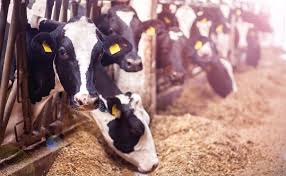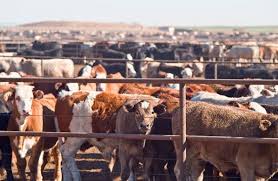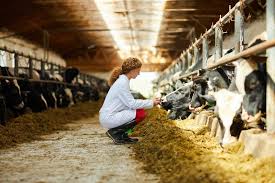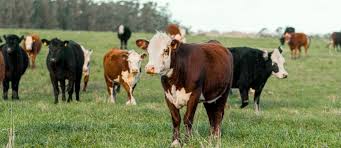Greenhouse gas emissions from livestock farming are a significant contributor to global climate change. The production of livestock generates various types of greenhouse gases, and associated activities like deforestation further exacerbate the problem.
Understanding the role of livestock farming in GHG emissions and deforestation is crucial for developing sustainable agricultural practices that reduce environmental harm.
Overview of Greenhouse Gas Emissions
1. Global Contribution: Livestock farming is responsible for a large portion of global greenhouse gas emissions, including methane (CH₄), nitrous oxide (N₂O), and carbon dioxide (CO₂). These gases trap heat in the atmosphere and contribute to global warming.
2. Sources of Emissions: Emissions from livestock come from multiple sources, including enteric fermentation (digestive processes), manure management, feed production, and land use changes like deforestation.
3. Scale of Impact: The scale of emissions from livestock varies by region, with more intensive farming practices and larger herds contributing to higher emissions.
Livestock Production and Greenhouse Gas Emissions

1. Enteric Fermentation: Ruminants like cattle, sheep, and goats produce methane during digestion. This process, known as enteric fermentation, is the largest single source of GHG emissions from livestock farming.
2. Manure Management: The way manure is stored and treated can release methane and nitrous oxide into the atmosphere. Poor manure management increases emissions significantly.
3. Feed Production: Growing feed for livestock, particularly in intensive farming systems, requires large amounts of energy and resources. The use of synthetic fertilizers in feed production contributes to nitrous oxide emissions.
Types of Greenhouse Gases in Livestock Farming
1. Methane (CH₄): Methane is a potent greenhouse gas, with livestock production being one of the largest sources globally. Methane is produced during the digestion of feed by ruminants and from manure management.
2. Nitrous Oxide (N₂O): Nitrous oxide emissions occur from the application of fertilizers in feed production and from manure. It is significantly more potent than CO₂ in terms of its warming potential.
3. Carbon Dioxide (CO₂): CO₂ emissions arise from deforestation, land-use changes, and the energy required for livestock farming operations, including transportation and feed processing.
Deforestation and Its Role in Emissions
1. Forest Conversion to Pastures: Forests are often cleared to create grazing land for livestock, leading to large-scale carbon emissions as trees that store CO₂ are cut down.
2. Loss of Carbon Sinks: Deforestation reduces the number of trees and plants that naturally absorb CO₂ from the atmosphere, exacerbating the increase in greenhouse gases.
3. Feed Crop Production: Large areas of forests are also cleared to grow feed crops like soy, further contributing to carbon emissions and the loss of biodiversity.
Impact of Livestock on Deforestation
1. Land Pressure: The demand for meat and dairy products has led to increased land use for livestock farming, driving deforestation, particularly in tropical regions like the Amazon rainforest.
2. Habitat Loss: Deforestation for livestock farming destroys habitats for many species, contributing to biodiversity loss and ecosystem imbalance.
3. Global Emissions: Livestock-induced deforestation contributes significantly to global carbon emissions, making it a major factor in climate change discussions.
Read Also: PawPaw/Papaya Style: Economic Importance, Uses and By-Products
Relationship Between Livestock Production and Land Use

1. Land Requirements for Livestock: Livestock production requires vast amounts of land for grazing and feed production. In many regions, forests and other ecosystems are cleared to meet the growing demand for animal-based products.
2. Pasture Expansion: Grazing lands for livestock account for around 26% of the Earth’s ice-free land. The expansion of pastures into forests contributes to habitat destruction and the release of stored carbon.
3. Feed Crop Cultivation: Intensive livestock farming often relies on crops like soy and corn for animal feed. The cultivation of these feed crops requires additional land, further increasing land use pressure.
Consequences of Greenhouse Gas Emissions from Deforestation
1. Increased Carbon Dioxide Levels: When forests are cleared for livestock production, stored carbon in trees and soil is released as CO₂, contributing to global warming.
2. Loss of Carbon Sinks: Forests act as carbon sinks by absorbing CO₂. Deforestation reduces this capacity, leading to a net increase in greenhouse gases in the atmosphere.
3. Biodiversity Loss: The destruction of forests to make room for livestock reduces biodiversity, impacting ecosystems that play vital roles in climate regulation and other ecological services.
Strategies to Reduce Emissions from Livestock
1. Improved Manure Management: Implementing better manure storage and treatment techniques can reduce methane and nitrous oxide emissions from livestock waste.
2. Feed Efficiency: Optimizing livestock diets to improve digestion and reduce methane emissions from enteric fermentation can significantly lower overall GHG emissions.
3. Rotational Grazing: Practicing rotational grazing helps maintain soil health and minimizes land degradation, reducing the need for deforestation.
Read Also: PawPaw/Papaya Trunck: Economic Importance, Uses and By-Products
Sustainable Livestock Farming Practices

1. Integrated Crop-Livestock Systems: Combining crop production with livestock farming allows for more efficient land use and better nutrient cycling, reducing the environmental impact.
2. Precision Farming: The use of technology to monitor and manage livestock farms more efficiently can reduce resource use, lower emissions, and improve sustainability.
3. Alternative Protein Sources: Encouraging the development and consumption of plant-based or lab-grown proteins can reduce the global demand for animal farming, easing land and resource pressures.
Reforestation and Land Restoration
1. Reforestation Initiatives: Planting trees in areas cleared for livestock can help restore carbon sinks and improve biodiversity, reducing the long-term environmental impact of deforestation.
2. Agroforestry Practices: Integrating trees into grazing lands (silvopasture) can improve soil health, provide shade for animals, and increase carbon sequestration, creating a more sustainable farming system.
3. Restoring Degraded Lands: By reclaiming and rehabilitating land degraded by overgrazing or deforestation, farmers can enhance soil productivity and reduce the need for further land conversion.
Livestock farming is a major driver of greenhouse gas emissions and deforestation. Addressing these challenges through sustainable practices can help reduce the environmental impact of the livestock industry and combat climate change.
Sustainable livestock farming practices, combined with reforestation and better land management, can help reduce greenhouse gas emissions and lessen the environmental footprint of livestock production.
Do you have any questions, suggestions, or contributions? If so, please feel free to use the comment box below to share your thoughts. We also encourage you to kindly share this information with others who might benefit from it. Since we can’t reach everyone at once, we truly appreciate your help in spreading the word. Thank you so much for your support and for sharing!
Read Also: A Comprehensive Guide To Circular Economy Consulting
Frequently Asked Questions
We will update this section soon.

